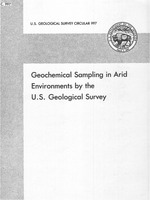The U.S. Geological Survey (USGS) is responsible for the geochemical evaluations used for mineral resource assessments of large tracts of public lands in the Western United States. Many of these lands are administered by the Bureau of Land Management (BLM) and are studied to determine their suitability or nonsuitability for wilderness designation.
Much of the Western United States is arid or semiarid. This report discusses various geochemical sample media that have been used for evaluating areas in arid environments and describes case histories in BLM wilderness study areas in which stream-sediment and heavy-mineral-concentrate sample media were compared. As a result of these case history studies, the nonmagnetic fraction of panned heavy-mineral concentrates was selected as the most effective medium for reconnaissance geochemical sampling for resources other than gold, in arid areas. Nonmagnetic heavy-mineral-concentrate samples provide the primary analytical information currently used in geochemical interpretations of mineral resource potential assessment of BLM lands.


